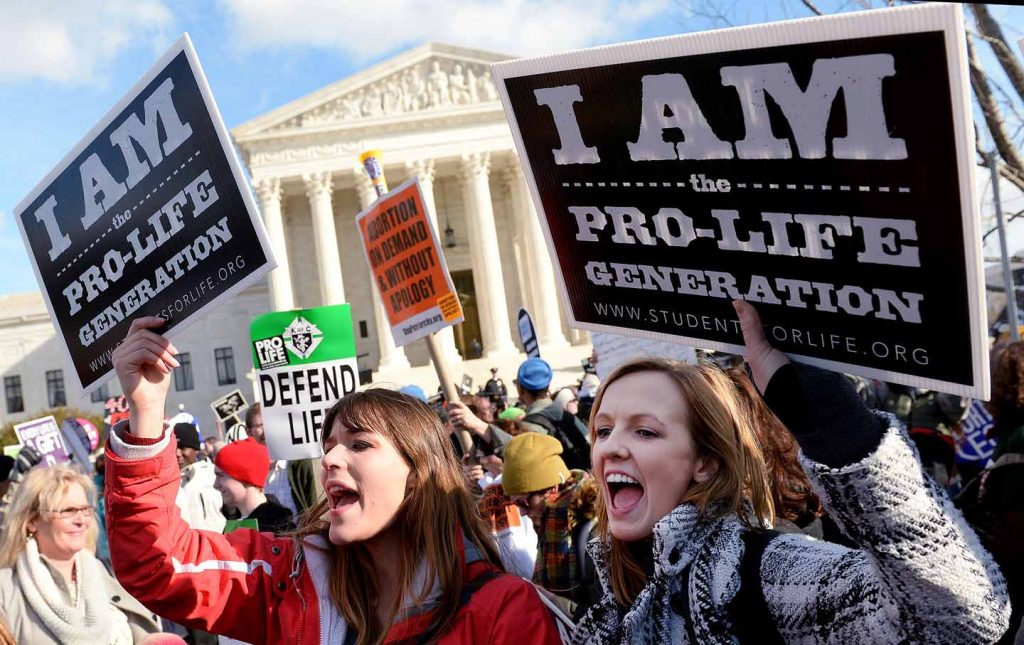Blog Post
How important is the Republican Party to the success of the pro-life movement?
By Jonathon Van Maren
On election night 2016, I was giving a pro-life presentation in a small prairie town in the middle of nowhere. As both a dual American-Canadian citizen as well as a long-time political junkie, I would usually have been fixated on a screen, eyes glued to the electoral college tallies. But for this race, there didn’t seem to be much of a point. The polls and the pundits all put Clinton’s chance of winning above 90%, and spending hours watching that unfold sounded like a depressing waste of an evening. Around 10 PM, leaving the presentation after packing up our materials with my colleague, I checked my phone. The polls were flipping fast, and I needed to find a TV. At 4 AM, I deleted the column I had pre-written explaining how the pro-life movement should respond to a Clinton victory, and started a new one on what her loss meant for the abortion wars.
I bring all of this up because a couple of recent essays have actually touched on what I wrote in my original election night column. Hillary Clinton’s victory would mean the Supreme Court was lost for a generation, I noted, but the pro-life movement’s primary victory—dramatically reducing the abortion rate over the past decade—has been won at the state level, not at the Supreme Court. In short, the way forward for the pro-life movement under a Clinton presidency would be identical to the way forward under Barack Obama. During the presidency of the most pro-abortion politician to sit in the Oval Office (he even voted against the Born Alive Infant’s Act), hundreds of state-level laws caused a consistent drop in the abortion rate. Even while Roe remained intact, the pro-life movement could strangle the abortion industry with red tape.
It appears that David French has reached much the same conclusion, which he lays out in an article titled “Do Pro-Lifers Who Reject Trump Have ‘Blood on their Hands’?” I’m not a Never Trumper (although I’m also not an enthusiast, and share many of their concerns), but I think much of his analysis should be encouraging to those of us who suspect that we may end up with a Biden presidency very soon (although 2016 has taught me to stay far away from predicting election results.) Consider:
Decades of data and decades of legal, political, and cultural developments have combined to teach us a few, simple realities about abortion in the United States:
- Presidents have been irrelevant to the abortion rate;
- Judges have been forces of stability, not change, in abortion law;
- State legislatures have had more influence on abortion than Congress;
- Even if Roe is overturned, abortion will be mostly unchanged in the U.S.; and
- The pro-life movement has an enormous cultural advantage.
If the points above don’t seem to make sense to you, then you’re likely unfamiliar with the way that decisive numbers of Americans think about abortion—not in crystal-clear terms of life versus choice (or “baby” versus “clump of cells”), but through much hazier and subjective reasoning. This means that absolutists are consistently frustrated with the political process. Unless Americans change, that process will not yield the results they seek.
But while many millions of Americans are hazy about the politics and morality of abortion, it’s apparent they have a bias about the practice of abortion. In their own lives, pregnancies are both increasingly rare and increasingly precious, and thus abortion is in steady decline, no matter who sits in the Oval Office.
Regardless of what you think of French’s political positions or his philosophy, this is encouraging because it is empowering. Pro-lifers can achieve incredible, life-saving results under a President Biden just as they did under President Obama. Is a pro-abortion president preferable? Obviously not. But it also doesn’t mean that we don’t have a wide range of effective tools in our arsenal. More:
- Presidents don’t really matter.
Let’s begin with a pop quiz. Who is the most pro-life president in the modern history of the United States? A surprising number of contemporary Republicans have a quick answer—Donald Trump. Not only is the answer wrong—other presidents have passed more substantial pro-life policies—the fact that any person could credibly think that’s the case is symbolic of historic presidential irrelevance.
For example, Trump is rightly praised for enacting new Title X regulations that required physical and financial separation of Title X projects from abortion-related activities. This decision has caused Planned Parenthood to withdraw from the Title X program. But the Trump rule is less strict than Title X rules promulgated under the Reagan administration.
Moreover, Trump has hardly “defunded” Planned Parenthood. In fact, Planned Parenthood received record-high taxpayer funding in 2019, performed a record-high number of abortions, and its affiliates received $80 million in coronavirus bailouts earlier this year.
Unlike George W. Bush—who signed into law a born-alive infant protection bill and a partial-birth abortion ban—Trump has not signed a single significant piece of pro-life legislation. But even Bush’s historic legislation merely nibbled at the edges of the abortion challenge. It’s exceedingly rare for babies to be born alive after botched abortions, and partial-birth abortion was barbaric but thankfully infrequent.
Yes, Republican presidents use the bully pulpit to advance the pro-life cause (and Trump is to be commended for speaking to the March for Life). And yes, Democratic presidents use the bully pulpit to hail “reproductive choice.” Remember when President Obama said that if his daughters made a mistake, he didn’t want them “punished with a baby”?
Regardless of the tweaks to the law, regardless of the bully pulpit, look back again at the numbers above. The abortion rate declines. The abortion ratio declines. They declined during pro-life and pro-choice presidencies. They declined when George W. Bush was president, and they declined when Barack Obama was president. If the decades-long trend holds, they’ll decline no matter who wins in November.
But astute readers will note I haven’t mentioned perhaps the president’s primary theoretical influence on abortion—judicial nominations. Have presidents (or the justices they’ve appointed) meaningfully moved the needle on abortion law since Roe? No, they have not. Let’s take a closer look.
I would quibble only slightly with French’s analysis here, as it leaves out the amount that Trump Administration officials have done in the international arena (and what presidents can do in this capacity). When I brought up this point to Austin Ruse of C-Fam—that Bush was more of a pro-life president than Trump—he responded by saying that the Trump Administration has been incredibly pro-active at the UN in pushing back against the abortion agenda, and that he and other veterans of the pro-life movement working in that sphere have never seen anything like it. So with that proviso, I think French’s point stands. More:
- Supreme Court justices are instruments of stability in abortion law.
I started the last section with a pop quiz. Let’s start this section with another. How many of the current Supreme Court justices have recently and unequivocally stated that Roe v. Wade and Planned Parenthood v. Casey (the two cases securing a constitutional right to an abortion) are bad law? Exactly one out of nine. It’s George H.W. Bush appointee Clarence Thomas.
The rest just voted to apply some variant of the Casey undue burden standard to a Louisiana statute requiring abortion doctors to have admitting privileges at a local hospital. The court struck down the Louisiana law by a complicated 4-1-4 vote, but one thing was clear—only Justice Thomas cast the abortion right in doubt, and no one else joined in his dissent. In fact, abortion jurisprudence has been relatively stable and intact since 1992.
To be fair, the state of Louisiana did not ask the court to overturn Roe, but Thomas stated his opinion. Any justice could have joined him. They chose not to. CNN later reported that Trump’s most recent Supreme Court appointee, Brett Kavanaugh, had urged the justices to sidestep the merits of the case entirely.
Now, you might object that previous presidents were “RINOs.” They didn’t have the guts to pick good justices. They wouldn’t fight like Trump does to put his man or woman on the court. But here again the historical record is not their friend. Even though previous justices were subject to filibusters, Republican presidents did, in reality, succeed in putting on the court justice after justice who had expressed opposition to Roe—including some of the most infamous abortion “squishes” in modern Supreme Court history.
As Carrie Severino recently noted, even justices David Souter, Anthony Kennedy, and Sandra Day O’Connor critiqued Roe before they joined the court. Souter filed a brief that called abortion “the killing of unborn children.” Kennedy once called Roe the “Dred Scott of our time.” O’Connor wrote that the court’s abortion decisions “have already worked a major distortion in the Court’s constitutional jurisprudence.”
Each of those justices joined the majority in Casey to preserve the right to an abortion. For almost three decades, the Supreme Court lesson has been clear—put not your trust in judges to rescue America from the moral stain of abortion.
- State legislatures are more effective than Congress.
One of the most frustrating aspects of modern right-wing political debate has been the claim that the conservative movement didn’t “win” before Trump. A conservative movement that was raised from the ground up to celebrate federalism ended up disregarding immense and substantive gains in state governments. For millions of populists, all that really mattered was the presidency.
For many reasons—including the state of abortion law—this is a profound mistake. In reality, the astonishing advance of the conservative movement in American states during the Obama administration yielded more concrete pro-life gains than anything the Trump administration has accomplished. Again, here’s a Guttmacher chart:
In fact, given this reality, it’s not too much to say that losing or winning state elections has proven to be more directly material to the law of abortion than 40 years of federal electoral contests. To understand the extent of state regulation, this piece compiles the sheer totals of state laws that regulate public funding, gestational requirements, waiting periods, parental involvement, physician involvement, and a host of other regulations and restrictions.
But given the extent of state legislation, doesn’t this make the Supreme Court even more important? After all, the court ultimately rules on the constitutionality of these regulations, and while overruling Roe and Casey won’t ban abortion nationally, it will grant these same states the ability to more heavily regulate abortion or even ban it within their borders.
Not so fast…
- Overruling Roe won’t touch the vast majority of American abortions.
This section might be the most dispiriting for pro-life readers. After all, overruling Roe has been the Holy Grail for the national pro-life movement for decades. End Roe, and you liberate the states. End Roe, and you can finally start working to ban abortion. So long as Roe stays, the law will remain unjust. It will permit the killing of innocent, unborn children.
But America is a very big, culturally and religiously diverse country. Support or opposition to Roe is hardly spread out evenly across the nation, and while there are many states that regulate abortion as much as they can, other states have passed laws to expand abortion access, and almost 100 million Americans live in states that provide public funding for abortions (the Hyde Amendment prohibits direct federal Medicaid funding for abortion, but it does not bind states).
One of the results of cultural and legal diversity is that states have wildly different abortion rates, and many of the states that have passed the strictest abortion laws already had low abortion rates. This interactive chart is a bit outdated (the data is from 2014), but still useful. It shows abortion rates varying from a low of 5 per 1,000 women (Utah) to a high of 29 in New York state. That’s immense variation.
The consequence is that overruling Roe would have a disproportionate effect in states with already-low abortion rates. A recent study calculated a potential 32.8 percent decrease in the abortion rate “for the regions at high risk of banning abortions.” But for the nation as a whole, the abortion rate would likely shrink by only 12.8 percent.
That’s right, even if the pro-life legal movement locates its Holy Grail, almost 90 percent of the American abortion regime would remain intact. The work of the pro-life movement would have to continue, largely as it continues today.
- But still, the pro-life movement has one immense advantage.
Earlier in this newsletter, I described the thinking of millions of Americans as “hazy” and “subjective.” They don’t fit neatly into a “pro-life” or “pro-choice” binary, either philosophically or politically. In fact, this muddled reality is one reason for the enduring abortion stalemate in American national politics. There are just aren’t enough single-issue voters to materially tip the balance of power.
But yet despite the muddle, the abortion rate and ratio continues to fall, and it’s fallen dramatically. Why? Last month researchers at Notre Dame issued a remarkable and interesting study called “How Americans Understand Abortion.” Their study wasn’t a simple poll that asked its subjects if they were “pro-life” or “pro-choice”—or whether they supported Roe. Instead, they conducted 217 in-depth interviews of a representative sample of the American population. Interestingly, abortion was not disclosed as the topic of the interview during recruitment.
The findings are fascinating. I could write an entire newsletter on its contents, but here are the top-line conclusions.
- Americans don’t talk much about abortion.
- Survey statistics oversimplify Americans’ abortion attitudes.
- Position labels are imprecise substitutes for actual views toward abortion.
- Abortion talk concerns as much what happens before and after as it does abortion itself.
- Americans ponder a “good life” as much as they do “life.”
- Abortion is not merely political to everyday Americans, but intimately personal.
- Americans don’t “want” abortion.
Each point is worth discussing. Each point is vital. I found the first point particularly poignant and the last point particularly pertinent. How many truthful, heartfelt conversations have you had in your entire life with friends or family about abortion? And no, I’m not talking about political conversations. I’m talking about genuine, transparent, and intimate conversations about personal lives.
In reading the study, it became clear to me that if you want to save unborn life, then improving the conditions of conception, birth, and post-natal life for mother, father, and child are vitally important. This is how real people work through abortion questions:
Americans focus much of their attention on abortion’s preconditions, alternatives, and aftereffects. We heard contemplations such as, What was the nature of the relationship between conceiving partners? Was it consensual? How did they approach pregnancy prevention, if at all? Was there sufficient knowledge about potential outcomes? What kinds of support (financial, relational) are available to people facing unplanned pregnancies? What are the stages of prenatal development? What health situations would put a mother or baby at risk? What does it take to raise a child (financially, parentally)? What impact does having a child have on professional aspirations, or on reputation, or on permanent ties between conceiving partners? What roles do (or can) men and women play in parenthood? How accessible is a choice like adoption? What are the conditions of children in foster care? This list of questions continues. The point here is that opinions on myriad social issues and corollary personal decisions frame attitudes well beyond the procedural “yes/no” or “right/wrong” of an abortion decision.
So, if all these questions come into play, and if the combination of Americans who are solidly pro-choice or more moderate in their attitudes vastly outnumber those Americans who are solidly pro-life from conception until natural death, then what is the pro-life movement’s immense advantage? It’s the last point. It’s the fact that abortion is not, ultimately, what people want:
None of the Americans we interviewed talked about abortion as a desirable good. Views range in terms of abortion’s preferred availability, justification, or need, but Americans do not uphold abortion as a happy event, or something they want more of. From restrictive to ambivalent to permissive, we instead heard about the desire to prevent, reduce, and eliminate potentially difficult or unexpected circumstances that predicate abortion decisions (whether of relationships, failed contraception, lack of education, financial hardship, or the like). Even those most supportive of abortion’s legality nonetheless talk about it as “hard,” “serious,” not “happy,” or benign at best. Stories from those who have had abortions are likewise harrowing, even when the person telling it retains a commitment to abortion’s availability. (Emphasis added.)
This is not the “shout your abortion” mindset of a tiny, tiny online fringe. The nation is full of women who want to have their children.
In other words, pro-life Americans may not be approaching a culture biased in favor of their political position, but they are approaching a culture that is biased in favor of the pro-life outcome—the birth of a child who is loved. And that bias is manifesting itself in a decades-long shift to a culture that is viewing pregnancy as increasingly purposeful and increasingly precious.
I’m not arguing that national politics don’t matter at all. A blue wave could end the Hyde Amendment and result in direct federal funding of abortions. The best available data indicates that would result in more abortions (though it’s far from clear that it would stop the overall decline in abortion rates and ratios), and it’s a reason why pro-life Americans should resist a Democratic takeover of the Senate.
But if you’re pro-life, the encouraging reality is those things that matter most—your relationships and your local political community—are the things over which you have the most influence. The things that matter the least—the presidency and national politics—are those things most removed from your daily life. But I’ve been around the pro-life movement enough to know that we often get this exactly backwards. We’re most passionate about the president. Yet too many of us are less interested in the crisis pregnancy center down the street. Without forsaking national politics, we can reverse that intensity, and if we reverse that intensity through loving, intentional outreach, we will reinforce the very decision the data and our experience tells us a woman wants to make.
I’d quibble with the assertion that most pro-lifers care more about the president than grassroots stuff—at least, I know for a fact that this isn’t true of rank-and-file members of the pro-life movement itself. If French is referring here to pro-life people in general, he’s probably correct. But what I do agree with is that this analysis is genuinely encouraging. It is extraordinary, when you really think about it, that the Sexual Revolution has won almost total victory on everything but abortion, where millions of pro-lifers have held the line for decades. Despite billions of dollars and the assistance of the entertainment industry and an entire wing of the political establishment, abortion activists can barely budge the polling data and the abortion rates keep on going down. This is genuinely good news. My only question to French with regard to what Joe Biden could do is on the Equality Act. If, as some have suggested, the Equality Act could wipe out all abortion restrictions on the state level overnight, then we are looking at a genuinely apocalyptic scenario for the pro-life movement, where decades of work would be wiped out at a single stroke.
The second essay on the subject of the limits of political power is by Michael Brendan Dougherty over at National Review. His analysis is similar to French’s in that he debunks the idea that voting in politicians is not the key front in the culture war, but his conclusion is also much bleaker:
[T]he Left has captured much of the permanent government. All of the culturally formative institutions of American life — public education, academia, the entertainment industry, and, increasingly, the rest of corporate America — are controlled by progressives, and as such are a gravitational force dragging the country leftward.Top of FormBottom of Form Don’t believe me? Neil Gorsuch ruled earlier this year that the 1964 Civil Rights Act protects transgender rights, even though it was passed years before academics invented the concept of transgenderism. The Big Tech companies are run by progressives. The sports leagues are bending the knee too. Major international corporations, while willing to meet with Republican politicians and occasionally throw a max-dollar contribution to a GOP congressmen to keep the regulators off their backs, will turn around and give a seven-figure donation to a progressive NGO or activist group.
The last four years should have proved that Republican officeholders — and Trump in particular — cannot achieve conservative aims in this environment. They can’t keep the Little Sisters of the Poor out of federal court. They can’t stop public schools from adopting the 1619 Project as the basis of their history curriculums. They can’t stop the government from funding “social science” that is designed to portray allegiance to family, place, and faith as fascistic, dangerous, and oppressive. And they can’t stop the riots. Trump can’t end the interminable foreign wars other Republicans started, and he can’t get the intelligence community or the military to stop leaking embarrassing information to the press. He can’t even get a cabinet confirmed.
In short, there is almost nothing the modern GOP can do. There is no principle this party, particularly as led by Trump, is capable of defending. The one thing it can do, beyond passing tax cuts, is deprive progressives of unified control of government and civil society. Given how unpopular some GOP policy goals are, I suspect that this may be the only reason Republicans continue to win office.
I agree with that, as well. In terms of mainstream culture, conservatives have lost the war on everything but abortion. That said, the revolutionaries in the Democratic Party still have a pretty long wishlist, and despite the relative powerlessness of the GOP (who can’t even get Planned Parenthood defunded), I’d rather have a Republican holding a seat just so a Democrat doesn’t have it. Self-defence voting isn’t so much about voting for someone because of what they might do, but against someone because you know what they will do. The GOP might be a leaky dam, but they’re better than nothing, and they’re a lot better than most of the so-called conservative parties in other western countries. In Canada, you have to pretend to be pro-choice even if you’re pro-life to win the leadership of the Conservative Party. In America, you have to pretend you’re pro-life even if you’re pro-choice to win the GOP presidential nomination. That’s not nothing.
All of this is to say that presidential politics are important, but not nearly as important as we may think they are. There is no replacement for grassroots activism, community work, and creating counter-cultures within the corrupt mainstream culture that is incurably cancerous. The good news is that doing these things turns out to be very effective.








